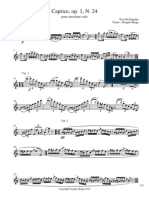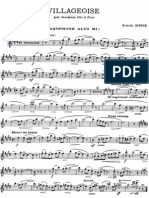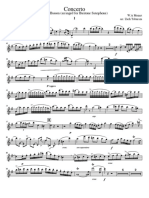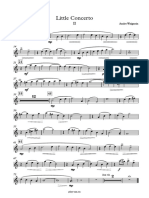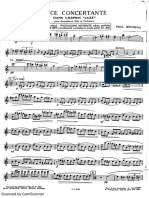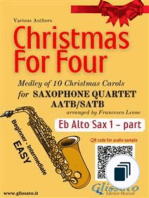Dubois Concerto 1
Dubois Concerto 1
Uploaded by
Jeremy HopkinsCopyright:
Available Formats
Dubois Concerto 1
Dubois Concerto 1
Uploaded by
Jeremy HopkinsCopyright
Available Formats
Share this document
Did you find this document useful?
Is this content inappropriate?
Copyright:
Available Formats
Dubois Concerto 1
Dubois Concerto 1
Uploaded by
Jeremy HopkinsCopyright:
Available Formats
Title: Concerto
Composer: Pierre Max Dubois
Dedication and Premiered by: Jean-Marie Londeix
Date of Composition: 11/3/1957
Publisher: Editions Musicales Alphonse Leduc
Instrumentation: Alto Saxophone and Orchestra
Number of Movements: Three
Time: 18 minutes
Range: Low A#Altissimo Bb
Comments:
If one is to perform this piece, Londeix’s fingering chart would be very useful in deciphering some notes.
Mvt 1
The opening recitative was added by Londeix. Large skips are found throughout the first page and should
be played with some rubato. The piano enters at mesuré (measured) on line five. The 64th note runs on page two
should be practiced such that four 64th notes get a beat; once it can be played quickly, speed the notes up and play
both lines in a single breath. Thirds are prevalent leading into the Allegro. This is where Dubois’ work begins.
Scaler passages and outlining chords are common throughout the first movement. The most difficult things about
this movement are accidentals and 16th note rests when not on the down-beat.
Mvt 2—Sarabande
This is a very beautifully written and lyrical movement. Articulations are rare, aside from those starting
slurred passages. The tempo marking, lento nostaligico, means to play slowly and with nostalgia. Starting in line
five, the orchestra plays the melody from the beginning of the saxophone part. The star at the end means that C#
may be played instead of the F# when an F# key is not present on the instrument.
Mvt 3—Rondo
This is a seven-part rondo. The first A section begins at the beginning, B at five after 2, A at two before 5,
C at four before 10, A at Tempo (two after 20), B at 21, and the final A section at 25. Many of the compositional
techniques from the first movement are used here but with fewer accidentals. Slur two followed by staccato notes
can be found in both first and third movements, but more so in the rondo. Outlining chords and scales in thirds can
be found, heavily, on the second to last page. Looking at the third from last line, 16th notes scales can be found,
moving up by a half step every beat. Ralentissant is the same as a rallentando, and the last measure is played
(suddenly) at tempo 1.
You might also like
- And Everything Is StillDocument2 pagesAnd Everything Is Stillcolinchaney27No ratings yet
- Two Preludes - Dorothy Chang - Piano ScoreDocument14 pagesTwo Preludes - Dorothy Chang - Piano ScoreJurij BregarNo ratings yet
- Swerts - KlonosDocument30 pagesSwerts - Klonosivor.pahi7No ratings yet
- PDF Caprice en Forme de Valse For Solo Saxophone PDFDocument3 pagesPDF Caprice en Forme de Valse For Solo Saxophone PDFgianinny duarteNo ratings yet
- Caprice, Op 1, N 24 Alto SaxophoneDocument5 pagesCaprice, Op 1, N 24 Alto SaxophoneGabrielFelipePerezPinedaNo ratings yet
- Indicaciones Anotaciones de Poem - HartleyDocument2 pagesIndicaciones Anotaciones de Poem - HartleyDaussaxNo ratings yet
- Rachmaninoff Sergei Vocalise (Sax Version)Document2 pagesRachmaninoff Sergei Vocalise (Sax Version)Kit Sax100% (1)
- REPERRTORIO SaxDocument6 pagesREPERRTORIO SaxMiguel Carbajal0% (1)
- MuczynskiDocument1 pageMuczynskiJack SmithNo ratings yet
- Bitsch - Villageoise (Solo)Document1 pageBitsch - Villageoise (Solo)Jeremy Williamson100% (1)
- Congreso Zagreb ProgramaDocument56 pagesCongreso Zagreb ProgramaAlexandre Gallego MedalNo ratings yet
- Saxorepbookscds 001 PDFDocument9 pagesSaxorepbookscds 001 PDFLuis VinaNo ratings yet
- Competition - Adolphe SaxDocument2 pagesCompetition - Adolphe Saxvulca00% (2)
- Mikroestructuras para Saxofón Tenor Solo (2002)Document4 pagesMikroestructuras para Saxofón Tenor Solo (2002)joraher100% (3)
- Vocations - Tomasi PDFDocument5 pagesVocations - Tomasi PDFSanti García MarcoNo ratings yet
- Balafon Saxophone LaubaDocument6 pagesBalafon Saxophone LaubarobertNo ratings yet
- Mozart K495 Baritone Sax 3rd MVTDocument15 pagesMozart K495 Baritone Sax 3rd MVTMaurice WuNo ratings yet
- Glazunov - Saxophone ConcertoDocument1 pageGlazunov - Saxophone ConcertoMatthew LynchNo ratings yet
- Brazilian Landscapes No.7: Liduino PitombeiraDocument7 pagesBrazilian Landscapes No.7: Liduino PitombeiraSergio AnguloNo ratings yet
- AubadeDocument1 pageAubadeVíctor Fabián ColaredaNo ratings yet
- Vacances - Damase PDFDocument1 pageVacances - Damase PDFAntonio SánchezNo ratings yet
- Concerto For Alto Saxophone and Wind Ensemble: I. Falcon FantasyDocument16 pagesConcerto For Alto Saxophone and Wind Ensemble: I. Falcon FantasyAadarsh BalireddyNo ratings yet
- Sax Prog NotesDocument25 pagesSax Prog NotesJohn100% (1)
- Sopran FlorioDocument7 pagesSopran Florior maNo ratings yet
- Runchak, V. - Concerto For Saxophone and Chamber Orchestra (Piano Version)Document30 pagesRunchak, V. - Concerto For Saxophone and Chamber Orchestra (Piano Version)Ita Nagode100% (1)
- Tango - Pour - Une - Princesse - Désésperée SopranoDocument3 pagesTango - Pour - Une - Princesse - Désésperée SopranoÁlvaro Madrigal LópezNo ratings yet
- Saxophone VacancesDocument1 pageSaxophone VacancesRocio Mira100% (2)
- GRAB IT! - Jacob Ter Veldhuis (Apuntes de Nicolás Miguel Linares Vadillo)Document9 pagesGRAB IT! - Jacob Ter Veldhuis (Apuntes de Nicolás Miguel Linares Vadillo)pelokiwiNo ratings yet
- Repertoire Tenor Alto SaxDocument14 pagesRepertoire Tenor Alto Saxyirson barcoNo ratings yet
- Mozart Bassoon Concerto (Bari Sax Arr.) MVT I Pierne Cad PDFDocument4 pagesMozart Bassoon Concerto (Bari Sax Arr.) MVT I Pierne Cad PDFZachry Tyler Taburaza100% (1)
- DC-Impressions II (Sax Part-AZ)Document6 pagesDC-Impressions II (Sax Part-AZ)STELLA FOURLANo ratings yet
- Sax Work StockausenDocument153 pagesSax Work StockausenStefano Franceschini0% (1)
- El Cisne Alto Saxophone Camille Saint SaënsDocument1 pageEl Cisne Alto Saxophone Camille Saint SaënsEnmanuel MejíaNo ratings yet
- The Unaccompanied Solos For Saxophone: Scholarly Notes To Accompany A CD Recording ProjectDocument17 pagesThe Unaccompanied Solos For Saxophone: Scholarly Notes To Accompany A CD Recording ProjectDANA100% (1)
- Nicholas Garrison Senior Recital - Baritone Saxophone, NayDocument6 pagesNicholas Garrison Senior Recital - Baritone Saxophone, NayEnTe SaxophonistNo ratings yet
- Prière. SaxDocument1 pagePrière. SaxPedroNo ratings yet
- Kirk O'Riordan: William Albright's Sonata For Alto Saxophone - A Study in Stylistic ContrastDocument30 pagesKirk O'Riordan: William Albright's Sonata For Alto Saxophone - A Study in Stylistic ContrasteightronNo ratings yet
- Ne? Two Etudes For Alto SaxophoneDocument3 pagesNe? Two Etudes For Alto SaxophoneKevin WilsonNo ratings yet
- Concertino HarveyDocument4 pagesConcertino HarveyTommaso BraviNo ratings yet
- Bach Duo I Alto Sax PDFDocument2 pagesBach Duo I Alto Sax PDFMar GNo ratings yet
- Lfy (I?: L'arlesienneDocument10 pagesLfy (I?: L'arlesienneYu Zheng WuNo ratings yet
- Concerto - Ronald Binge - SaxDocument8 pagesConcerto - Ronald Binge - SaxCarolina Martins100% (1)
- Program NotesDocument3 pagesProgram NotesBrett Jackson100% (1)
- Installation: DE EN FR IT NL ES PT DK NO SE FI IS PL HU SK CZ SL HR SR MZ AL EE LV LT BG RO GR TR RU CN AEDocument4 pagesInstallation: DE EN FR IT NL ES PT DK NO SE FI IS PL HU SK CZ SL HR SR MZ AL EE LV LT BG RO GR TR RU CN AEssgrunfNo ratings yet
- Fantasie No 7 Telemann (Arr. Saxophone)Document3 pagesFantasie No 7 Telemann (Arr. Saxophone)kazarinskiNo ratings yet
- Andre Waignein - Little Concerto (II, III) (Soprano Saxophone)Document2 pagesAndre Waignein - Little Concerto (II, III) (Soprano Saxophone)lopata67No ratings yet
- J.B.Singelee - Caprice. Op.8 (Piano)Document8 pagesJ.B.Singelee - Caprice. Op.8 (Piano)Hayrapet ArakelyanNo ratings yet
- Le Api: Antonio Pasculli Transcribed by Aidan RichardsonDocument9 pagesLe Api: Antonio Pasculli Transcribed by Aidan RichardsonJulianaVandersonNo ratings yet
- Crazy Logic PDFDocument10 pagesCrazy Logic PDFinesdc5No ratings yet
- Saxophone Audition RepertoireDocument3 pagesSaxophone Audition RepertoireAugusto Rodriguez100% (1)
- Art of Interpretation Part 5 - Program Note Final Draft - Brian Kachur (GSI - Chuyi Zhu)Document1 pageArt of Interpretation Part 5 - Program Note Final Draft - Brian Kachur (GSI - Chuyi Zhu)BrianKachurNo ratings yet
- The Symphonious Saxophone - A History of The Large Saxophone EnseDocument93 pagesThe Symphonious Saxophone - A History of The Large Saxophone EnseLuca Bartelloni100% (1)
- Londex Londex2017 Final Final Web PDFDocument84 pagesLondex Londex2017 Final Final Web PDFLorenzo SimoniNo ratings yet
- Paul Bonneau Kontsertnaya Pyesa V Dzhazovom Stile PartiaDocument34 pagesPaul Bonneau Kontsertnaya Pyesa V Dzhazovom Stile PartiaStasNo ratings yet
- Booklet ONYX4065Document18 pagesBooklet ONYX4065chenamberNo ratings yet
- Saxophone Quartet "Little" Fugue in G minor (set of parts): intermediate levelFrom EverandSaxophone Quartet "Little" Fugue in G minor (set of parts): intermediate levelRating: 5 out of 5 stars5/5 (1)
- Christmas for Four - medley for Saxophone QuartetFrom EverandChristmas for Four - medley for Saxophone QuartetNo ratings yet




